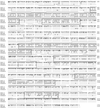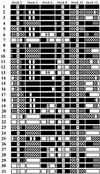Mosaic organization and heterogeneity in frequency of allelic recombination of the Plasmodium vivax merozoite surface protein-1 locus
- PMID: 12466500
- PMCID: PMC138614
- DOI: 10.1073/pnas.252348999
Mosaic organization and heterogeneity in frequency of allelic recombination of the Plasmodium vivax merozoite surface protein-1 locus
Abstract
The organization and allelic recombination of the merozoite surface protein-1 gene of Plasmodium vivax (PvMsp-1), the most widely prevalent human malaria parasite, were evaluated in complete nucleotide sequences of 40 isolates from various geographic areas. Alignment of 31 distinct alleles revealed the mosaic organization of PvMsp-1, consisting of seven interallele conserved blocks flanked by six variable blocks. The variable blocks showed extensive variation in repeats and nonrepeat unique sequences. Numerous recombination sites were distributed throughout PvMsp-1, in both conserved blocks and variable block unique sequences, and the distribution was not uniform. Heterozygosity of PvMsp-1 alleles was higher in Asia (0.953 +/- 0.009) than in Brazil (0.813 +/- 0.047). No identical alleles were shared between Asia and Brazil, whereas all but one variable block nonrepeat sequence found in Brazil occurred in Asia. These observations suggest that P. vivax populations in Asia are ancestral to Brazilian populations, and that PvMsp-1 has heterogeneity in frequency of allelic recombination events. Recurrent origins of new PvMsp-1 alleles by repeated recombination events were supported by a rapid decline in linkage disequilibrium between pairs of synonymous sites with increasing nucleotide distance, with little linkage disequilibrium at a distance of over 3 kb in a P. vivax population from Thailand, evidence for an effectively high recombination rate of the parasite. Meanwhile, highly reduced nucleotide diversity was noted in a region encoding the 19-kDa C-terminal epidermal growth factor-like domain of merozoite surface protein-1, a vaccine candidate.
Figures




References
-
- Mendis K., Sina, B. J., Marchesini, P. & Carter, R. (2001) Am. J. Trop. Med. Hyg. 64, 97-106. - PubMed
-
- Udagama P. V., Gamage-Mendis, A. C., David, P. H., Peiris, J. S. M., Perera, K. L. R. L., Mendis, K. N. & Carter, R. (1990) Am. J. Trop. Med. Hyg. 42, 104-110. - PubMed
-
- Holder A. A. (1988) Prog. Allergy 41, 72-97. - PubMed
Publication types
MeSH terms
Substances
Associated data
- Actions
- Actions
- Actions
- Actions
- Actions
- Actions
- Actions
- Actions
- Actions
- Actions
- Actions
- Actions
- Actions
- Actions
- Actions
- Actions
- Actions
- Actions
- Actions
- Actions
- Actions
- Actions
- Actions
- Actions
- Actions
- Actions
- Actions
- Actions
- Actions
- Actions
- Actions
- Actions
- Actions
- Actions
- Actions
- Actions
- Actions
- Actions
- Actions
- Actions
- Actions
- Actions
LinkOut - more resources
Full Text Sources
Other Literature Sources
Research Materials

